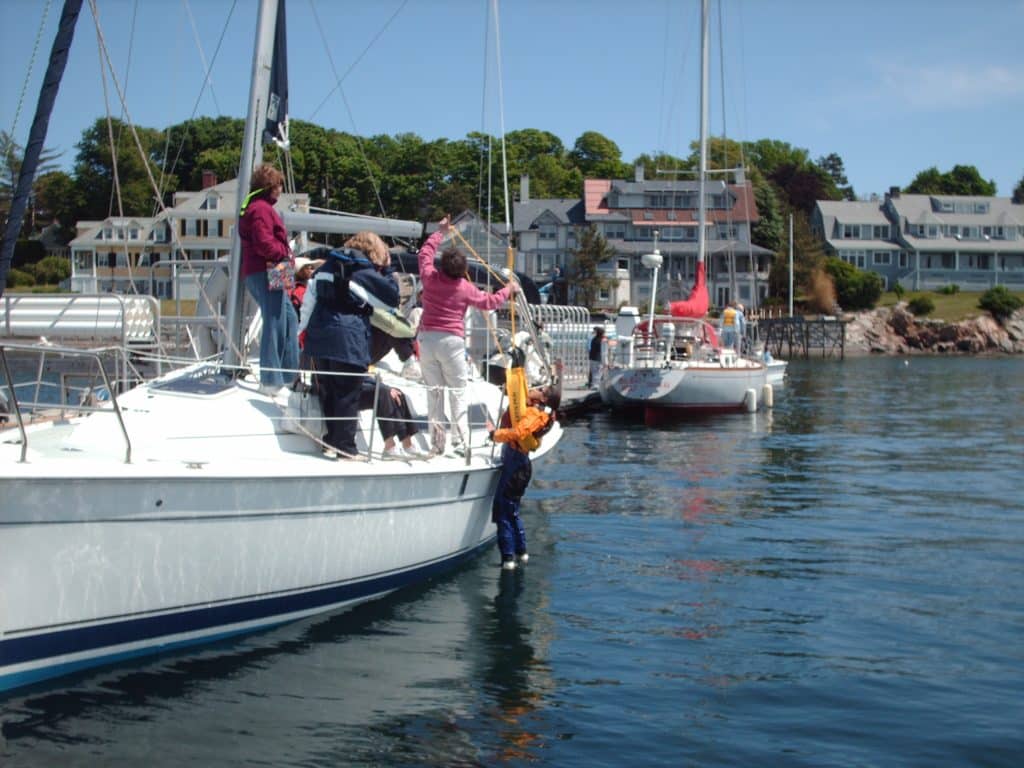
Women’s Sailing
While I am certainly no expert on education, I do believe that, in general, men and women learn and communicate in different ways, and that these differences are often intensified on the water. This has, over the years, given me a keen interest in sailing education where women learn from other women. With this in mind, I was eager to attend the National Women’s Sailing Association’s 10th annual Women’s Sailing Conference, which took place on June 4th at the Corinthian Yacht Club in Marblehead, Massachusetts.
The Women’s Sailing Conference is a full day of activity beginning at about 8:30 a.m. with breakfast and then flowing into the workshops and on-the-water clinics. My morning looked full with a marine medicine class followed by diesel engine troubleshooting—two areas where I was hoping to fill in some personal knowledge gaps. Taught by an experienced ER nurse and sailor, the marine medicine class covered lots of ground in the hour and 20 minutes allotted to it. Within this short block of time, it’s impossible to cover any topic in much depth, but I left with a better understanding of what topics I would like to know more about. The instructor also reminded us of the most common accidents and illnesses onboard (galley burns, sunburns, seasickness, bruises, strains, sprains) and the most serious (concussions and head injuries, hypothermia, dehydration) and gave us suggestions about what to put in our first-aid kits.
My morning then continued with the diesel troubleshooting class. This one I was particularly excited about because I really need to improve my understanding of my boat’s engine. Our instructor for this class, an experienced sailor who runs her own women’s sailing school aboard her boat, taught us diesel-engine basics in an easy-to-follow way. To drive home the point of just how important diesel engine maintenance is, she brought in an example of a shredded impeller, a jar of really dirty engine oil, and personal stories of what can happen if we don’t see—or just ignore—our engine’s trouble signals. One participant in the class summed it up by saying, “These are things that my husband has been trying to teach me for years, but now I finally get it!”
This is something that’s fairly common to hear throughout the day at the Women’s Sailing Conference, and that’s the point. “The workshop leaders and coaches are passionate about sailing,” says Joan Thayer, president of the Women’s Sailing Association. “And they are able to communicate that passion to the novice sailor. Women are willing to share their fears and their dreams and learn from one another.”
My afternoon included classes on marine weather and emergency seamanship, both amazingly thorough considering the short time frame allowed. I left with a renewed energy to really look over and inventory all my flares and lifejackets, and a better understanding of marine weather systems. Other classes include everything from knot tying and spinnaker setting to sailing singlehanded and even a galley cooking class.
In my opinion, though, the best part of the conference is meeting the other participants—women who are new to sailing, others who have been doing it all their lives, cruisers, racers, young, and not so young. Most were from New England, but there were plenty there from as far away as California, Washington state, and Florida. “I enjoy seeing the camaraderie among so many, the laughter and the new found friends that have been made,” remarks Joan Thayer. “It’s a day for women and I’m glad we can make it such a positive one.”
Rounding out our day at the lovely Corinthian Yacht Club was a buffet lunch and, later in the evening, dinner and a presentation by the keynote speaker, Doris Colgate, founder of the National Women’s Sailing Association and the Women’s Sailing Foundation and co-owner of Offshore Sailing School. There was also a very popular raffle and silent auction, and all proceeds went to the Women’s Sailing Foundation, which supports the AdventureSail program for young girls at risk.
For more information about the National Women’s Sailing Association or their annual conference, go to the association’s website (www.womensailing.org).







